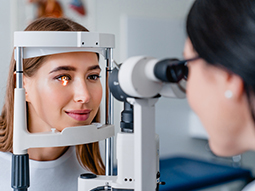What is a refractive error?
A refractive error is an abnormality or change to the physical shape of the eye, causing vision impairment. The eye focuses images by refracting (or bending) light through the cornea and lens. If these structures are atypically shaped, light cannot be refracted correctly and vision is blurred.
Our Ophthalmology team has the expertise to diagnose and treat the four types of refractive errors. Your clinician will work with you to assess your vision and discuss your treatment options.
Types of refractive errors
There are four primary types of refractive errors:
- Myopia (nearsightedness): Often presenting in the childhood or teenage years and sometimes persisting through adulthood, myopia blurs distant objects.
- Hyperopia (farsightedness): Commonly presenting in childhood and sometimes persisting through adulthood, hyperopia blurs close-range objects. Untreated hyperopia can sometimes cause strabismus (“crossed eyes”) or amblyopia (“lazy eye”).
- Presbyopia: This type of refractive error is caused by a hardening of the eye’s lens, due to aging. Like hyperopia, it makes it harder to see objects at close range.
- Astigmatism: Caused by an uneven curve in the shape of the eye’s cornea, this type of refractive error causes vision blurring at both near and far range. Usually, this type of refractive error is present at birth.
Symptoms of refractive errors
Symptoms of refractive errors include:
- Blurry, wavy, or double vision
- Halos around lights
- Eye strain
- Difficulty reading or driving
- Headaches
Diagnosis of refractive errors
Refractive errors can be diagnosed during an eye exam. A member of your ophthalmology care team will talk with you about your symptoms and medical history. He or she will want to know about the issues you are experiencing with your eyes, as well as any medications you are taking or medical conditions you may have. Refractive errors can be easily confused with other eye or medical conditions, so your care team will consider all factors when formulating a diagnosis.
Next, a member of your ophthalmology team will ask you to read off an eye chart, and will test your vision using different lenses. Your clinician may use dilating eye drops to get a better view of your eyes. If your doctor needs to dilate your eyes, you will experience some light sensitivity and blurred near vision for a few hours after the exam.
Treatment for refractive errors
Refractive errors are typically treated with prescription eyeglasses or contact lenses. Contact lenses are an option even for patients with astigmatism and presbyopia. Some patients may choose to have refractive surgery (such as LASIK) to permanently correct vision problems. Your ophthalmologist or optometrist will talk through your options so that you can together decide upon the best care plan for you.
Our providers

Expert ophthalmology care
Getting the care you need starts with seeing one of our ophthalmologists.









